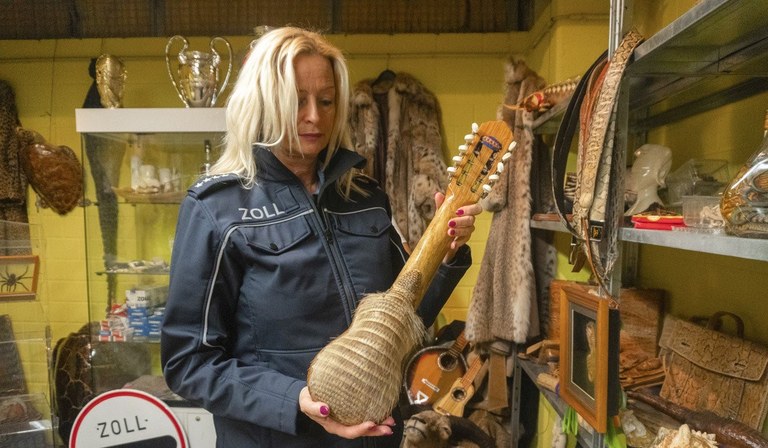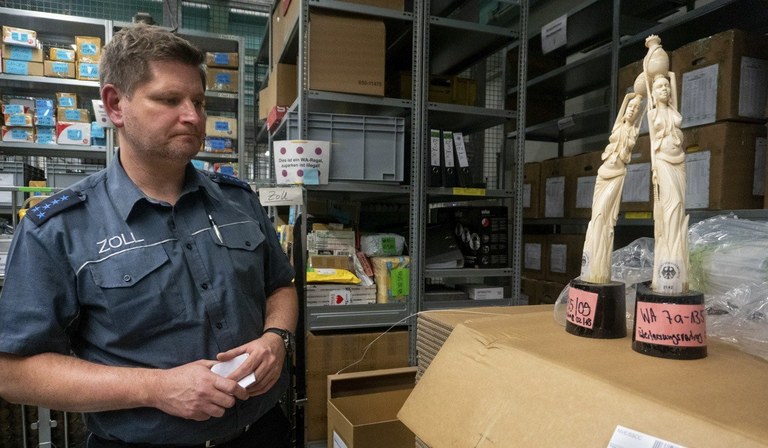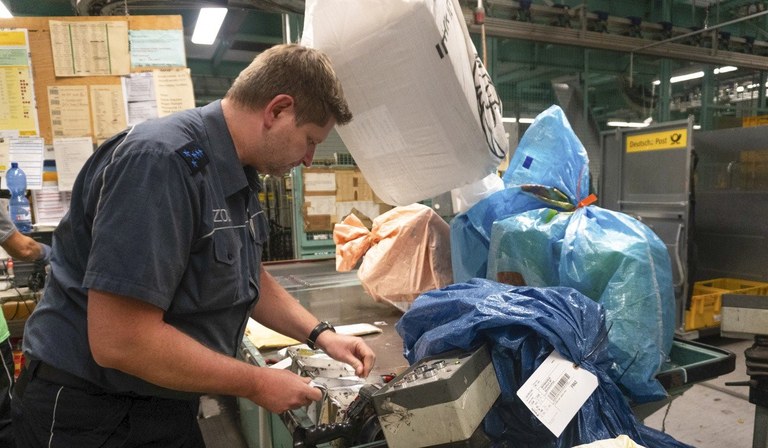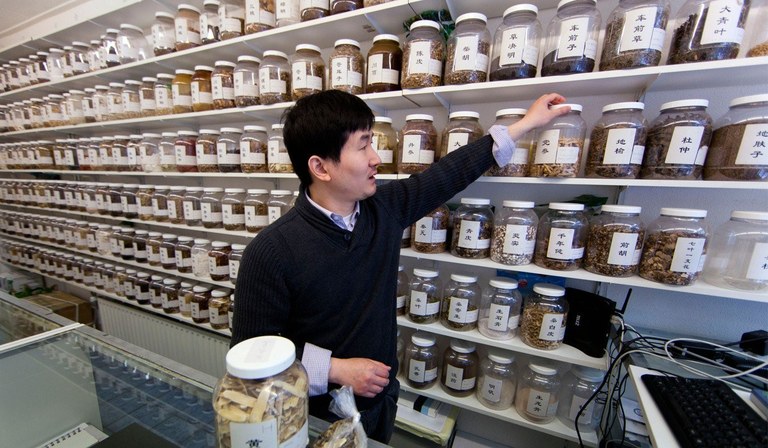
14 Jan Ideal cover for wildlife traffickers
Wildlife criminals are increasingly using Europe’s mail and online retail delivery services to smuggle their contraband. Denise Hruby investigates

Prime opportunity: Christmas mail at the International Postal Centre in Frankfurt, Germany. Photo: Denise Hruby
Wrapped in plastic bags marked with case numbers, the remains of elephants, bears, mountain lions, polar foxes and crocodiles are neatly stored on grey metal shelves at Frankfurt Airport’s International Postal Centre.
“Confiscated” reads a sign in German, in the fenced-in corner of the nondescript warehouse. It’s an unworthy last resting place for some of the world’s most enigmatic animals – or at least the parts of them that have been turned into rugs, decorative statues, jackets and wallets.
Under usual circumstances, December isn’t a good time to visit the centre. This is peak season for international mail, the most hectic time of year, when delivery services and logistics companies handle twice the usual volume due to Christmas deliveries.
But in between shifts, during a few minutes of peace and quiet when the conveyor belts have been halted and X-ray scanners switched off, Marcus Redanz devotes some time to showing a selection of the wildlife and related products his team has detected in packages bound for German addresses.
“If I’m a criminal, then it would make sense to try and smuggle wildlife now,” says the customs inspector.
The vast increase in deliveries over the Christmas period represents a prime opportunity for wildlife smugglers, who anticipate fewer interceptions while delivery services, post offices and inspectors such as Redanz are overwhelmed.

In the mail: Customs officer Marcus Redanz with statues made of ivory seized by his team at the International Postal Centre in Frankfurt, Germany. Photo: Denise Hruby
Transit hub
Criminal networks have turned the trade in protected and endangered species into the world’s fourth-largest black market, worth an estimated US$23-billion each year. It would be a mistake to assume that the trade flows only in one direction, from Africa to Asia.
There has been an increase in contraband sent in the mail from Asia to Europe, says Redanz. Last year his team seized a polar fox jacket sent from China, for example, and spiders, lizards and geckos from countries such as Thailand are occasional arrivals.
Europe’s roles as trafficking transit hub, source and destination are all more pronounced than is generally acknowledged. In 2016, the European Union accepted that it “has an important role to play in tackling this traffic” and that “lack of awareness and political engagement are also major obstacles to combating trafficking effectively.”
Law enforcement and customs agents across the world have ramped up their efforts to combat the trade, but sophisticated smuggling syndicates are taking advantage of the international shipping industry, which is at its most stretched during the Christmas rush. In the weeks before and after December 25, the number of parcels passing through airports such as Frankfurt more than doubles, figures from several mail services show.

Redanz and his team detected 5,550 individual trafficked animals and plants in 2017. Photo: Denise Hruby
International deliveries
Wedged between a shiny glass Deutsche Post building and the passenger arrival and departure halls, the International Postal Centre is the largest in Germany and among the largest in Europe.
Redanz estimates that, on an average day, he and his 90 colleagues inspect 10,000 to 12,000 parcels, in the process enforcing duties and taxes that add in to the €6-billion the central Frankfurt customs office takes in a year. In 2017 his team detected 5,550 individual trafficked animals and plants, as well as products made of or containing parts, concealed in international deliveries.
Deutsche Post planned to hire an additional 10,000 seasonal workers in 2018 to handle the increase in Christmas deliveries, most of them due to e-commerce, while the country’s private delivery service DPDgroup deployed an additional 12,000 trucks.
“If you see what’s going on in the international parcel industry today, and how it has grown, it’s just enormous,” said Harold Gerretsen, an inspector with the Nederlandse Voedsel-en Warenautoriteit, the Dutch food and consumer product safety authority, which is responsible for detecting violations of CITES, the international treaty to protect endangered species, and works closely with Dutch customs.
Schiphol airport, in Amsterdam, and the port of Rotterdam, Europe’s largest, have been identified as hot spots for wildlife trafficking by the European Parliament.
“Everything is ordered online now, and especially with Christmas, it’s even more. There must be so many parcels that slip through without anyone noticing,” said Gerretsen.
About 8.2-million incoming and outgoing containers passed through Rotterdam in 2017 – 800,000 more than in the previous year. The port was the world’s busiest until 2004, but despite the staggering growth in containers and volume, today it doesn’t even make the top 10. Hong Kong, Singapore and Shanghai have, along with other ports in Asia, dwarfed Rotterdam, standing testament to how rapidly the Asian market and the international shipping industry have grown.
Gerretsen has conducted countless inspections in Rotterdam over the years, especially in the 1990s, when Chinese traditional medicine ingredients were often found in cargo containers. In the 1980s, while working as a customs officer, he came across a container from Vietnam that held an Indian elephant and a brown bear, both still alive.
Since the 1990s, he’s focused on wildlife trafficking, following international syndicates specialising in the exotic bird trade halfway across the world, to South America and the Middle East.
“This job has taken me to countries I’d have never thought I’d visit,” he said.
At least 136 countries recorded wildlife trafficking seizures between 2009 and 2017, involving more than 7,000 species, ranging from tiny lizards and other reptiles to the eggs of rare birds and tigers and lions destined for petting zoos, according to Routes (Reducing Opportunities for Unlawful Transport of Endangered Species), a USAID-led partnership aimed at combating wildlife trafficking that includes logistics companies, government agencies, law enforcement, wildlife NGOs such as Traffic and other groups.
Gerretsen says that although containers full of trafficked wildlife continue to be intercepted, big hauls are becoming rarer. Instead, smaller shipments sent through delivery services are growing.
“The best way to smuggle is to go with the flow, wherever the stream is biggest,” he says. “If you have millions of parcels every year, how much can you possibly inspect?” The fast growth in the number of parcel deliveries in an online-retail world makes it impossible for inspectors to keep up.

Unworthy resting place: Christine Strass, head of communications for customs in Frankfurt, holds a seized string instrument made in part from an armadillo. Photo: Denise Hruby
Small packages
Cross-border retail has been growing by an average of 25% per year globally – twice as fast as domestic retail, according to DHL, the world’s largest international delivery service.
Estimated success rates in intercepting trafficked wildlife vary widely. The most often quoted figure is 10%. If that were accurate, nine out of 10 shipments would be making it past park rangers, local law enforcement, security checks at ports and airports, and customs agents. But many experts believe that 10% is wishful thinking.
“That number, that’s bollocks,” said Daan van Uhm, a doctor in criminal law at the University of Utrecht, in the Netherlands, who specialises in wildlife trafficking in Europe. “I believe it’s much lower.”
Van Uhm was drawn to the problem because nobody else, law enforcement agents included, seemed to be paying attention: “It wasn’t seen as a job for real men, because within the man man world, animals aren’t a hot topic,” he said.
Public awareness, social norms and values have shifted, making wildlife trafficking a serious crime. Yet the risk of getting caught is still very low, van Uhm said.
“In the illegal underworld, it doesn’t matter if you are talking about cocaine or wildlife trafficking: it’s the smaller packages that work,” he said. Smaller packages help mitigate overall losses to an operation, and are less likely to lead to an investigation that could expose an entire network.
“If it gets followed up at all, [the recipient] can also just say it wasn’t for them, that they’ve never ordered it. At most, they’ll get a small fine, but there won’t be a big investigation,” van Uhm said.
Ethnic Chinese, who first settled in the Netherlands more than 100 years ago, are particularly fond of small deliveries, which help meet the demand for traditional medicine, a trade van Uhm has researched extensively.
When a rhino is poached in a national park in South Africa, when a pangolin is trapped in a snare in the tropical forests of Laos, or when a tiger is shot in Malaysia, parts of the animal will probably be used to treat ailments that range from rheumatism, fever, lack of lactation, arthritis, eczema and epilepsy to ulcers and pimples.
There is little to no scientific evidence to back such treatments, but in large part due to this trade, China is by far the most common destination for trafficked wildlife, Routes finds.

A Chinese traditional medicine shop in the Netherlands. Photo: Alamy
Chinese medicine
In the Netherlands, about 40% of a total of 1,634 wildlife seizures in 2013 and 2014 were linked to Chinese medicine, according to a European Parliament report.
In 2018 a case in the Czech Republic implicated Europe further in the international wildlife trade. When customs agents began discovering tiger bones in the possession of ethnic Vietnamese criminals en route for Vietnam, and products made from tiger bones in a predominantly Vietnamese market in Prague, they grew suspicious. In a three-year investigation that cost tens of thousands of euros, investigators uncovered farms on which tigers were being bred, killed and cut up.
“The difficulty with cases like this: first, you have a big language barrier, so you need to get a translator, someone you can trust. And then, it also takes a lot of time, a lot of people, and it’s very, very expensive to do,” says Pavla Rihova, a lead inspector in the case.
Think of a man, around 30 years old, ethnically Asian, transiting at a European airport on his way to China. Perhaps he’s queuing at a coffee shop, or lounging in a chair in the departure lounge. What would it take for you to notice him? He would blend in with the 160,000 passengers that, on average, passed through Schiphol each day in December 2017.
For trained customs and law enforcement officials, risk-assessment observations add up. Not everything can be inspected, so customs and law enforcement officers at ports, airports and postal centres prioritise highest-risk packages and individuals. Often, this includes some degree of racial profiling.
This young traveller from China – a real person – would have raised several flags: he was travelling alone; he had checked in a heavy box; he was arriving on a flight from South Africa, which, together with Mozambique, accounts for nearly 50% of all air-traffic rhino horn seizures; he held a Chinese passport and was returning to the market of greatest demand for trafficked wildlife.
Agents don’t usually inspect packages in transit, but the risk analysis of this man’s luggage would have been high. They opened the box he had checked in and found inside the horns of five rhinos and 450 blank South African visas, according to Dutch court documents.
The court sentenced the man to 12 months in prison, reasoning that the five horns alone would have been worth up to €500,000, and because such individuals are key links in the criminal chain of wildlife trafficking.
At Christmas time in 2018 he was due to be released, free to travel again. Whether he returns to trafficking wildlife or not, his network is probably still operating: the poachers, the forgers who create hundreds of fake visas, the buyers and other middlemen who would have been involved in such a large haul.

The departure hall at Frankfurt Airport. Photo: Alamy
Shipping industry
All of those interviewed for this story believe that wildlife trafficking is on the increase, especially in connection to China, despite the fact that Beijing last year banned the import of ivory.
Traffic, the global wildlife trade monitoring organisation, says customs and law enforcement agents need the support of the international shipping industry in helping to spot suspicious parcels and packages, and of check-in and other ground staff at airports to help flag individuals and their baggage.
“That they are using the same routes we are using, whether that’s mail or passenger travel, can actually be a big opportunity,” said Michelle Owen, who leads the Routes-Traffic partnership, which is creating a framework under which to provide training to customs agents, and is working with airlines and the delivery industry to find ways to address the issue.
“There’s so much to do, and I really think it’s just getting more and more,” Gerretsen said.
He and his colleague have wanted to inspect one particular trader for several years, concerned that he might be selling macaws poached from the wild alongside those he breeds, but until now their resources haven’t allowed for it.
“I’m a realist, I know how things are going” Gerretsen said. “But when I see how much [traffickers] are doing to mislead us, and how scared they are, I know we are doing a good job.”
This investigation was published by South China Morning Post and was funded by a grant from Internews’ Earth Journalism Network
